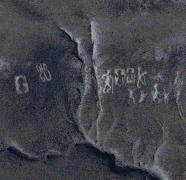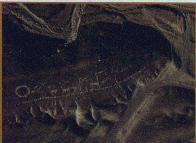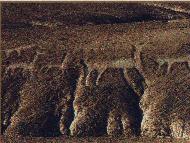


by Persis B. Clarkson
Giant images of llamas, lizards, cats, birds, and fish are scrawled across the deserts of northern Chile. Alongside them once moved long caravans of llamas that carried the coin of the prehistoric Andes corn, fish, potatoes, copper, turquoise and cotton from the coastal lowlands to the high mountains. This commerce of centuries carved deep trails as long-lasting as the great geoglyphs drawn one atop the other in the Atacama Desert. Geoglyphs sprawling, puzzling images created on the landscape itself are unusual, but scattered widely around the world. They are found in the Atacama Desert of northern Chile, the Nazca plains of Peru, the chalk hills of southern England, and the Mohave Desert in Arizona. All share two ingredients: the canvas (a suitable surface for creating images) and the paintbrush (a simple, efficient technology for making geoglyphs). In Oxfordshire, England, a layer of soil and mossy vegetation was chipped away in the shape of a 110-meter-long (360-foot-long) horse to reveal the white, underlying chalk. In desert regions, images were created by moving aside the dark pebbles on the surface to expose the lighter, underlying soils, or by piling stones into desired forms. Since studying the geoglyphs of Nazca, arguably the most famous in the world, in the 1980s, I turned my attention to the more numerous but far less well-known images spread among the hills and canyons of northern Chile, 1,000 kilometers (600 miles) south of Nazca. The Chilean geoglyphs are often clustered images especially a line of camelids (a family of South American animals that includes llamas, alpacas, vicuZ as and guanacoes), sometimes accompanied by human-like figures. Single images may be camelids, but they might also depict giant lizards, felines, fish, birds, crosses, checkerboards, and, less frequently, humans. The individual images display no particular relationship to each other and no specific orientation. They may measure less than a meter (three feet) in height to 115 meters (377 feet) (the "Atacama Giant"). The camelid lines can be up to 75 meters (246 feet) long, and can include up to 40 animals. The geoglyphs of Nazca and Chile bear some superficial similarities but no apparent connection. The techniques of creating the geoglyphs in Chile and Nazca are identical, and the size ranges overlap. Both landscapes the canvas of the geoglyphs feature stony surfaces of discolored pebbles upon alluvial silts and sands. A Unique Location But thats where the similarities end. The Nazca images often overlap those used on Nazca pottery, and they are quite different from the subjects of Chilean geoglyphs. The Chilean geoglyphs are unique in the world in a fundamental way: Most of them follow ancient caravan routes that ran east-west between the Andes and the Pacific coast, and north-south between oases in the desert.
The Atacama Geoglyphs are more numerous and widespread than their more famous counparts at Nazca. They are found in the Chilean Atacama desert in the nort east of the country. They can be found in an area of over 100 square miles . They depict many subjects, Llamas and similar animals e.g. vicunas. Lizards, fish, birds, crosses, humans, chessboards and other geometric designs.
They can be found alone or in groups some as many as 65 geoglyphs. The smallest figure is about 1m tall and the largest the Atacama Giant 115m high. They are found near major trade routes in the area and like all geoglyphs can only be seen from the air. Dating these geoglyphs is very difficult as newer ones have been overlaid, there is some evidence that they may be 2500 years old.